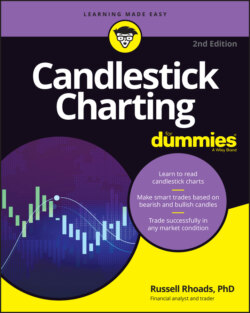Читать книгу Candlestick Charting For Dummies - Russell Rhoads - Страница 8
ОглавлениеIntroduction
When I wrote the first version of this book, candlestick charts were a known method of displaying and analyzing price data but weren’t the default charting method for most traders. Now, more than ten years later, the charts shown in the business media are often candlestick charts. This situation is fully understandable, because candlestick charts are better visuals than line charts or bar charts. But even though candlestick charts are common nowadays, most traders still don’t understand candlestick patterns, much less use them in day-to-day trading.
After the first edition of this book was published, I received some criticism that I spent too much time discussing instances in which candlestick patterns didn’t work out. One of the top reasons why traders fail, however, is that they don’t take losses even when it makes sense. Whenever a trader enters a trade, they should have an exit plan that involves taking either losses or profits. This book sticks with the format of showing both profitable and losing trades for each pattern.
About This Book
This book isn’t intended to be an end-all-and-be-all guide to profitable trading. It’s meant to provide readers some insight into how candlesticks are created and how they can be used to analyze the psychology behind what happens over the course of trading days. (When I say psychology, I’m not trying to conjure up images of Freud and Rorschach tests; I’m talking about the motivating factors that determine how the market behaves.)
I made an effort to use as many examples as possible in the text, and every example comes from actual charts, showing you not only how common candlestick patterns are in everyday trading, but also how they’re used them in live trades. They’re waiting for you to harness their power!
Also, for each new candlestick pattern that I introduce, I present at least one case that produces a useful signal and one that produces a dud. Candlesticks are terrific, but they’re not perfect, and recognizing the failure of a signal is just as important as picking up on a valid signal.
I hope that the candlestick methods described in this book help you make trading and investment decisions that lead to solid profits, but unfortunately, I can’t guarantee those profits. What I can guarantee is that after reading this book, you’ll understand what candlesticks are, what they represent, and how to use them effectively in trading.
Foolish Assumptions
Knowledge of candlesticks varies widely from trader to trader. Even traders with the same amount of trading experience can differ quite a bit in their candlestick know-how. So I’ve made these assumptions about you:
You have at most a very basic understanding of what comprises a candlestick chart. (My apologies if you already know a little about candlesticks, but hey, it never hurts to review and hone essential candlestick skills.)
You have some sort of experience in trading a stock or at least a mutual fund.
You’ve spent some time looking over stock charts.
Icons Used in This Book
I used the following icons throughout the book to point out various types of information:
When you see this icon, you want to store the accompanying nugget of candlestick or trading wisdom somewhere safe in your brain.
This icon offers hands-on advice that you can put into practice as you trade. In many cases, the information next to this icon tells you directly how to conduct a trade on a pattern or technical analysis method.
If you ignore this information, you might wake up one day in a den full of writhing, angry pit vipers. Okay, things won’t get that bad, but this icon can help you avoid making costly trading mistakes.
This icon flags places where I get really technical about charting. Although the information is great, you can safely skip it without missing out on the discussion at hand.
Beyond the Book
In addition to the scintillating text in your hands, this book comes with a free access-anywhere Cheat Sheet that you can use when you need a quick refresher on common candlestick patterns or trading tips. To get this Cheat Sheet, simply go to www.dummies.com and type Candlestick Charting For Dummies Cheat Sheet in the Search box.
Where to Go from Here
To figure out which area of this book to dive into first, think hard about what facet of candlestick charting you want to understand. Do you want to get grounded in the basics or polish up on a few candlestick fundamentals that you’ve forgotten since you read that online article about candlestick charting months ago? Check out Part 1.
If you want to get cracking by finding out about a few real candlestick patterns and seeing how they can tell you what a market or security is going to do next, check out one of the chapters in Part 2 or 3. I cover many candlestick patterns in those chapters — enough to give you plenty to look for as you pore over charts on the web or in a charting software package.
You may have been exposed to some other technical indicators, and it’s possible that reading about candlesticks alongside some of that familiar material may help you get your feet wet. If so, make a beeline for Part 4, and enjoy! I’ve also added some quick summaries and resources in Part 5, so check that out, too.
The water’s fine no matter where you choose to dive in, and you’re just a few page-turns away from adding a powerful weapon to your trading arsenal.
